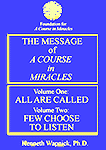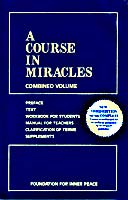

THE COURSE'S USE OF LANGUAGE
- I
THE SYMBOLISM OF DUALITY
Chapter 2 of FEW CHOOSE TO LISTEN
from
Volume Two of THE
MESSAGE OF A COURSE IN MIRACLES
By Kenneth Wapnick, Ph.D.
Introduction
Perhaps the greatest source of confusion to students of A Course in Miracles is its inconsistent and metaphoric use of language, especially since most students are probably not even aware of such usage. This confusion unfortunately can well serve the ego as a tempting justification for those who would already be prone to misinterpreting the Course's teachings in light of the strong investment in maintaining and defending their own belief system. Thus, the Course's poetic style can be one of the greatest obstacles for those students whose bent is towards more literal if not fundamentalist interpretations of what they read. This approach may work well with more scientific writings, where precision of statement is essential, but such rigidity regarding form wreaks havoc with the Course's content. While some discussion of this theme occurred in All Are Called (e.g., pp. 32-36), the current chapter addresses this very important issue in greater depth.
The Course's Metaphoric
Language
We begin therefore by stating simply that A Course in Miracles is not written as a scientific tract, nor as a professional research paper, as was Helen's usual style of writing. Rather, the Course's use of language is frequently poetic, and its style symphonic and not linear, as we saw in the preceding chapter. While this is certainly an advantage to readers familiar and comfortable with such a style, such writing, again, can become extremely frustrating to those who prefer more technically precise prose. I shall always remember the man who stood up at a workshop Gloria and I were giving many years ago, after our discussion of some of the translations of A Course in Miracles that were then either already in progress, or being considered. He spoke quite forcefully of his background as a Ph.D. in Engineering, as well as his being a rather literate and intelligent man, but yet one who was not able to understand the Course at all. "When," he concluded his remarks by saying, "are you going to translate this Course into English?"We quoted earlier Jesus' comment from the text: "You have surely begun to realize that this is a very practical course, and one that means exactly what it says" (T-8.IX.8:1). The problem is, however, that the Course's words often do not mean what they say literally, and further, are not meant to be taken that way. But the words certainly do mean what they say when they are understood metaphorically or symbolically, and this meaning can be discerned when the content behind their form is recognized.* Consider a few examples:
Jesus makes some statements about the incorruptibility of the body, suggesting that it cannot die (T-19.IV-C.5:2; M- 1 2.5:5), which when taken out of context certainly do seem to suggest that the body's life can be immortal. And those students of the Course who subscribe to other spiritualities that do emphasize the immortality of the body leap for joy as they seize upon the Course's literal words to support the claims of their own spiritual path. Their conclusion then is that A Course in Miracles is "just like" this other path because they both advocate the immortality of the body, and hold that up therefore as an important if not essential goal for the spiritual seeker and student of the Course.
However, what these passages in the Course really mean is that the body does not die because the body does not live. As the text says:
The body no more dies that it can feel. It does nothing. Of itself it is neither corruptible nor incorruptible. It is nothing (T-19.IV-C.5:2-5).Therefore, in that sense only can we say that the body does not die, for what does not possess life cannot lose it. It would make no sense if Jesus in A Course in Miracles advocated the immortality of a body that throughout the three books he teaches is not real and has no life. Yet this is an example of where well-meaning students can become confused by not recognizing, again, where specific statements are not to be wrenched from their context and taken as literal truth.A group of examples dealing with God make the point very well of paying attention to the content behind the form. Incidentally, the italics in the following quotations are mine, and in the last quote I have omitted those found in the Course since they related to stylistic considerations and not to the passage's meaning:
God is lonely without His Sons, and they are lonely without Him .... God Himself is lonely when His Sons do not know Him (T-2.III.5:11; T-7.VII.10:7; italics mine).
God weeps at the "sacrifice" of His children who believe they are lost to Him (T-5.VII.4:5; italics mine).
"God Himself is incomplete without me."... For by it [sin] God Himself is changed, and rendered incomplete (T-9.VII.8:2; T-19.II.2:7; italics mine).
Indeed, throughout A Course in Miracles God is referred to as having Arms, Hands, and a Voice, and with this "body" of His reacts to His Son's mistakes by taking steps, reaching down, speaking words, creating plans, etc.
It would be obvious to even a casual reader of A Course in Miracles that God is not and cannot be corporeal. He does not have a body, nor does He live in a place called Heaven. In fact, we are taught that the physical world was made as an attack on Him (W-pII.3.2:1), and that the body is a limit on love (T-18.VIII.1:2). And yet in the passages above we are specifically told that God is lonely, weeps, and is incomplete without us. Not only do these words clearly imply that God exists in a body -- as other passages do as well by referring to Him as Father, denoting His masculine humanity by use of the human pronouns "He" and "Him," and referring to the body parts noted above -- but also these passages clearly suggest that the separation from Him actually happened; otherwise, He could not be reacting to it as He is clearly described in places as doing. However, it is the principle of the Atonement, upon which rests the whole thought system of the Course, that the sin of separation never happened at all. Thus our resultant guilt and fear make no sense. And just as nonsensical is the thought that God -- our perfect Creator and undifferentiated and unified Source -- could weep, suffer loneliness, or even believe that He were incomplete.In the sections to come, I shall explain what Jesus truly means in these symbolic references, but I continue now with a brief presentation of some passages that involve the creation of the Holy Spirit. A Course in Miracles says that He was created by God as His Answer to the ego's thought of separation. For example:
[The Holy Spirit] came into being with the separation as a protection, inspiring the Atonement principle at the same time .... The Holy Spirit is God's Answer to the separation. ... The principle of the Atonement and the separation began at the same time. When the ego was made, God placed in the mind the call to joy (T-5.I.5:2; T-5.II.2:5-3:2).
Later the text states, in another reference to the creation of the Holy Spirit, that when God's extension outward was blocked by the separation, "He thought, 'My children sleep and must be awakened' " (T-6.V.1:8).
In these quotations, only a few among many, many others, it is clear that the words themselves directly imply a human God, who thinks, feels, and acts as would a loving parent when confronted by a wayward child. The God of the gospel parables naturally is portrayed in exactly the same way. The Creator-God of the Old Testament is also clearly depicted as a very human father, though not always in a positive fashion, to say the very least. Given our strong bodily identification, such an image of God is understandable:Can you who see yourself within a body know yourself as an idea? Everything you recognize you identify with externals, something outside itself. You cannot even think of God without a body, or in some form you think you recognize (T-18.VIII.1:5-7).In addition, the Judaeo-Christian tradition with which almost all students of A Course in Miracles identify -- whether they are conscious of it or not -- would make it practically impossible not to conceptualize the Creator in human terms, both physically and psychologically. How then should we understand these continual references in the Course to a very human -- (if not at times ego--) sounding deity? The next sections address this question.---------------------------------------------------------------------------------------------------------------------------------------- * Again, this issue is explored in depth in Gloria's and my article "A Simple, Clear, and Direct Course," which is published on the Web at: http://facim.org/acim/lh930404.htmI, PART TWO =>
Links to all parts
of THE COURSE'S USE OF LANGUAGE
| I, part 1 | I, part 2 | I, part 3 | I, part 4 | I, part 5 | I, part 6 |
| II, part 1 | II, part 2 | II, part 3 | II, part 4 |
Miracle Studies Navigation Table